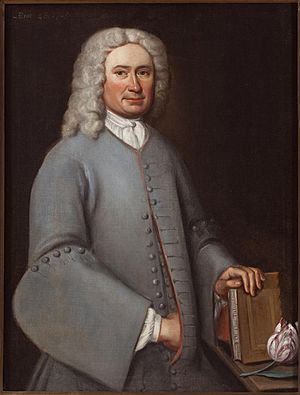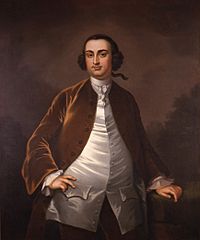John Custis facts for kids
Quick facts for kids
John Custis
Esq.
|
|
|---|---|

Portrait by Charles Bridges, 1725
|
|
| Member of the House of Burgesses for Northampton County |
|
| In office 1705–1706 Serving with William Waters
|
|
| Preceded by | Benjamin Nottingham |
| Succeeded by | Benjamin Nottingham |
| Member of the House of Burgesses for the College of William & Mary |
|
| In office 1718–1719 |
|
| Preceded by | Peter Beverley |
| Succeeded by | Thomas Jones |
| Personal details | |
| Born | August 1678 Arlington, Virginia |
| Died | November 22, 1749 (aged 71) Williamsburg, Virginia |
| Spouse |
Frances Parke
(m. 1706) |
| Children | 5 |
| Parent |
|
| Profession | Planter, politician |
| Military service | |
| Allegiance | British America (1735–1749) |
| Branch/service | Virginia Militia (1735–1749) |
| Rank | Colonel |
Colonel John Custis IV (born August 1678 – died November 22, 1749) was an important person in early Virginia. He was a farmer, a politician, and a military officer. He served in the House of Burgesses, which was like Virginia's government assembly. He represented Northampton County from 1705 to 1706 and the College of William & Mary from 1718 to 1719. John Custis IV was part of a well-known family in Virginia. He used his large land properties to pursue his love for gardening and plants.
John Custis IV was born in 1678 into a family that owned large farms called plantations. These plantations used the labor of enslaved people. When he was young, he went to London, England, to learn about the tobacco business. In 1699, he returned to Virginia to learn how to manage his family's plantation and the enslaved workers there. In 1705, he was elected to the Virginia General Assembly. He served for one year. In 1706, he married Frances Parke.
In 1714, John Custis IV's father passed away. John then took control of the family's large estates, which included two plantations and many enslaved people. His wife, Frances, died two years later. In 1717, John Custis IV moved to Williamsburg, Virginia. There, he became interested in politics again. He was elected to the assembly for another year. In 1727, he became a member of the Virginia Governor's Council. This was a powerful group that advised the governor.
In 1735, Custis bought another large farm called the White House plantation. He arranged for his son, Daniel, to manage it. In his later years, John Custis IV became very ill. He was removed from the Governor's Council in August 1749. He wrote his will and testament on November 14, 1749, and died eight days later. John Custis IV was buried in his family's cemetery. His estate then went to his son, Daniel.
Early Life and Education
John Custis IV was born in August 1678. His birthplace was Arlington in Northampton County, Virginia. His father was John Custis III. He was also a well-known farmer and a member of the Governor's Council. John Custis IV's mother was Margaret Michael Custis. She had six more children after John, but she died during childbirth.
As the first son, John Custis IV received private lessons at home. Later, his grandfather, John Custis II, sent him to England. There, he studied with Micajah Perry, a tobacco merchant and politician. When John Custis IV turned 21 in 1699, he returned to Virginia. He went to his grandfather's plantation in Arlington. There, he learned about the tobacco business in Virginia. He also learned how to manage the enslaved people who worked on the plantation.
In 1705, Custis was elected to the House of Burgesses. This was the lower house of the General Assembly of Virginia. He represented Northampton County. Unlike his father, Custis only served one term. He decided not to run for re-election in 1706. On May 4, 1706, he married Frances Parke. She was the oldest daughter of Daniel Parke. In the same year, Custis was appointed as a justice of the peace. This meant he helped keep law and order.
A Career in Politics
John Custis IV and Frances lived in the same house after they married. However, their relationship became very difficult. They often refused to speak to each other. Instead, they would communicate through their enslaved servants. One of these servants was named Pompey. Their great-grandson, George Washington Parke Custis, later said their marriage was not happy for long.
On January 26, 1714, John Custis IV's father died. John then took control of the family's property. This included about 7,000 acres of land. It had two plantations, Arlington and another in Northumberland County. He also inherited 30 enslaved people. On March 14, 1715, Frances died from smallpox at Arlington. Two years later, in 1717, Custis moved from his plantation. He went to the city of Williamsburg, which was the capital of Virginia.
In Williamsburg, Custis became interested in politics again. He ran for election to the House of Burgesses once more. This time, he ran for the College of William & Mary area. The college had been founded in 1693 and was given a seat in the House. Voters connected to the college elected him. He served until 1718. During this time, his Arlington plantation burned down. Custis decided not to rebuild it. Growing and selling tobacco was becoming less profitable.
Custis did not want to live at his father's Northumberland County plantation. Instead, he settled in Williamsburg. He lived there for the rest of his life. In the city, he built a large colonial house. It was called the Six Chimney House. Many enslaved servants worked for him there. Next to the house, Custis created a large, four-acre garden. This showed his growing interest in horticulture, which is the art of growing plants. He even wrote letters to famous plant experts like John Bartram, Mark Catesby, and Peter Collinson.
On September 11, 1727, Custis was appointed to the Governor's Council. Eight years later, he bought the White House plantation. This farm was along the Pamunkey River in New Kent County. He bought it from another farmer, John Lightfoot III, and inherited the enslaved people there. Custis then sent his son, Daniel, to manage the White House. Daniel was 25 years old at the time. He learned how to run a plantation that used enslaved labor. Around this time, Custis also became a colonel in the Virginia Militia.
Later Years and Legacy

As John Custis IV got older, he started to have health problems. He wrote to his plant expert friends for health advice. In 1742, Collinson sent him a letter with medical suggestions. Custis replied that it was "impossible... to take a case... without seeing the patient." Custis continued to expand his garden in Williamsburg. He planted many fir and pine trees.
In 1744, Custis asked the governor of Virginia, Sir William Gooch, and the Governor's Council for something unusual. He asked them to free an enslaved child. This child was named John, but often called Jack. Custis believed this child should be free. This request was very rare for a wealthy plantation owner in Virginia.
When Daniel was 37, he met 16-year-old Martha Dandridge. They met at St. Peter's Church. Daniel was a church leader there, and Martha attended services. They soon started a romantic relationship. John Custis IV first did not want Daniel to marry Martha. This was because her family was not as wealthy. However, he eventually agreed. The couple married on May 15, 1750, after dating for about two years.
In his last years, Custis became very sick. He was too ill to do his duties. So, he was removed from the Governor's Council on August 26, 1749. He also started writing his last will. He finished it by November 14, 1749. He died on November 22 in Williamsburg. As he wished, Custis was buried near Cheapside, Virginia, in the Custis Tombs. This was the family cemetery of the Arlington plantation.
Since Daniel was his only son who lived to adulthood, Custis left his plantations to him. This included the White House plantation. Daniel and Martha moved there after they married. Custis also asked for a special phrase to be carved on his gravestone. It said: "Yet lived but Seven years which was the Space of time he kept a Batchelors House at Arlington on the Eastern Shoar of Virginia." His great-grandson, George Washington Parke Custis, said this message was meant to show how unhappy his difficult marriage had been.
Family and Interests
John Custis IV and Frances had four children during their marriage. Their relationship was often difficult. Two of their sons died young. A daughter, Frances, married but died without children before November 1749. Daniel was their only son to live to adulthood. Both of Custis's young children who died were buried at the Custis Tombs. When Daniel died on July 8, 1757, in New Kent County, it was likely from a sudden heart attack. He was buried in the churchyard of the Bruton Parish Church in Williamsburg.
Custis married Frances partly because of her family's wealth. However, her father had many large debts. These debts were passed to Frances after her father died in Antigua in 1710. The debts were even larger than her father's property. This meant Custis and Daniel had to work hard to deal with them. Custis later wrote that his life at Arlington before he married was his happiest time. His difficult personality and unhappy marriage with Frances became a topic of discussion for many years.
Besides his gardening, Custis also became interested in collecting art. In 1723, he wrote to his friend William Byrd II. Byrd was visiting London at the time. Custis asked him to buy "two pieces of as good painting as you can procure." He wanted to put them in his house to cover the fireplaces in summer. Two years later, in 1725, Custis asked English artist Charles Bridges to paint his portrait. As of 2008, this painting is at the Washington and Lee University in Lexington, Virginia.
After inheriting the plantations, Daniel settled down in Virginia. He became a part of the wealthy plantation-owning class. He and Martha had four children. However, only two lived past childhood: a son named John and a daughter named Martha. Losing two of his children may have contributed to Daniel's early death in 1757 at age 45. After Daniel died, Martha married George Washington. He was a well-known farmer and soldier. He later led the Continental Army in the Revolutionary War.

